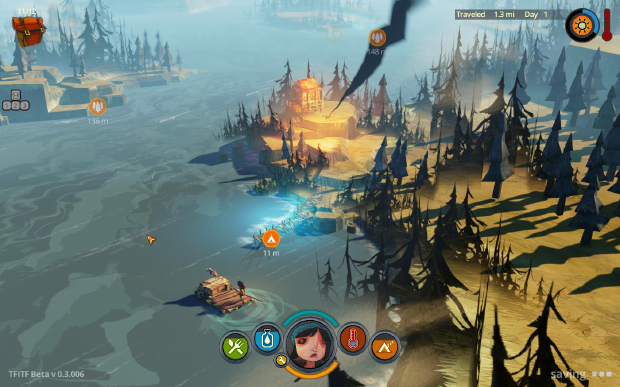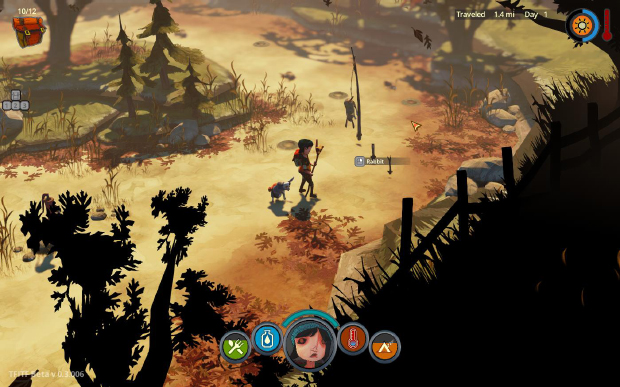Premature Evaluation: The Flame In The Flood
Raft 'n' Craft
Each week Marsh Davies paddles through the polluted torrent which is Early Access and comes back with any stories he can find, or otherwise tumbles overboard and lets himself sink beneath the surging water. This week he’s been fighting against the tide in The Flame In The Flood [official site], a survival game set in a drowned world, in which a girl and her dog paddle between islands looking for resources - then eventually fail to find them and die.
Games that successfully ignite the imagination suffer under a particular curse: with every evocation of a greater, richer world beyond the borders of the game’s mechanics, the journey between “I want to play this” and “I actually like playing this” grows ever longer and more perilous. Looking at The Flame In The Flood, it’s so easy to imagine stories that the game, in its current bare-bones state, just doesn’t offer. The artists may simply have done too good a job: the sumptuous, saturated colours give such a sense of scale and atmosphere to its sketchy, polygonal landscape, and its tumble-down wood-panelled buildings describe an appealing rural Americana that is dramatically threatened by the raging river which has consumed all but the highest points of the land. What better narrative propellent than a surging torrent of water buoying you forever onward? What better excuse for neatly vignetted experience than the islands you might stop at on the way? Then there’s your own character, Scout, who immediately feels so, well, characterful: her oversized head and soulful eyes give her a childlike vulnerability, but her expression is one of stoic perseverance, of certain capability.
Then you play the game and discover that actually Scout is, in crude totality, a series of numbers that are always getting smaller, and the islands she can visit little more than fortune cookies which may temporarily allay that process or hasten it. Most survival games can be described by such a mean reduction, but few of the good ones are as bleakly beholden to random number generation. And the river, with all its dramatic potential, is a jolly white-water mini-game that takes you between an arbitrary choice of islands, interspersing the doleful act of item collection, inventory juggling and crafting. Concept art suggests a much richer range of interactions to come, but in the only available mode of the current Early Access build, there is no narrative to your exploration beyond survival, and your survival is dictated primarily by luck rather than strategy. At the moment, you only really have three options: find the stuff you need on an island, go to another island, or die. As far as I can tell, there is no particular approach you can take which will improve the odds you are presented with, beyond attaining a quick familiarity with the game’s arbitrary crafting recipes.
Hunger, thirst, health, body temperature and energy - the constant clamour of these statistics, and the fact that each island may only have meagre resources to fulfil one or two of these needs, is the game’s central tension. Judging when to move on is key. Your inventory has a frustratingly tiny amount of space, too, so you’ll quickly need to gamble between which crafting recipes you work towards, sustained only by the hope that the next island will furnish you with the remaining ingredients. If you’re thirsty, you’ll need to make sure you can craft water filters, so you can make the contaminated river water safe. If you’re hungry, you’ll need to put your efforts into building traps to snag rabbits. If you are injured or ill, you’ll have to craft specific medicines or splints. This sounds like it could become interesting, but the current balance of the game makes it all very reactive: the only real choice here is to choose to do what you must, or, more likely, simply what you can.
I do enjoy how granular the horrors you can suffer are, and how they are often the result of an earlier compromise, kicking the can of your mortality down the road rather than kicking the bucket then and there. If you’re hungry enough, you can eat raw meat - though you may well get intestinal parasites. If you’re too busy surviving to treat a wound, then you’ll be faced with a bacterial infection down the line. Healing these harsher ailments is always more complicated than the initial problem, but, when you’re in a pinch, it might be worth the gamble that you’ll hit a treasure trove of resources later on.
Mostly, however, this isn’t a choice: you just don’t find the resources to deal with whatever conditions you face, and are bounced between a series of equally inevitable unpleasantries until death. I have my feet lacerated by ants - not that I recognised the wandering motes to be ants when I walked into them. (And I wouldn’t have necessarily assumed that ants could lacerate me through the shoes I had on, either, but nevermind.) This issue is presented as a growing red bar I need to address before the lacerations become a bacterial infection. A tooltip tells me I need aloe to treat such a wound, but the random number generator determines that I shall never locate any. Stumbling on with my rotting feet, I come across a pig which attacks me - there’s no way for me to escape. I fall over, get up, and it attacks me again. And again. I can’t really do much about this. I manage to flee into a house (the pig continues to break my bones as my house-entering animation completes) but as soon as I’ve finished sleeping the game turfs me out of it, and the pig immediately mauls me again. I now have a large number of broken bones, so I figure this run is a lost cause and let the pig gore me until I am dead.
Pigs are OP.
It’s a little early in the game’s development to complain too harshly about the UI, but the way inventory, wearable items and crafting menus are divided up makes it a bit of a hassle when deciding what to craft, or how much, or determining what amount of backpack space that will free up. I wish the dog didn’t bark at every potential inventory item, even things you’ve discarded (which, confusingly, become suitcases). I wish it was easier, too, to tell what items will do for you just by looking at them, rather than having to make space in your inventory to then inspect them. The major weakness of all crafting/survival games is that recipes are necessarily an abstraction and not always easy to intuit - having the UI help you along the way mitigates some of this. I wish your inventory was larger. Like, a lot larger.
A campaign mode is promised to come soon, and this may well provide the greater narrative purpose I feel the game is missing. Right now, the Early Access build is all about the endless mode - a roguelike score-attack in which you attempt to beat previous records of survival and distance travelled. Alec seems to have had a better time playing earlier versions of the game, albeit with some caveats, but I find this stripped-back mode struggles to grab me at a mechanical level: I'm too beholden to necessity and luck to think for myself. Oddly, and entirely counter to Alec’s experience, I found the rafting mini-game to be the most engaging part - it's gorgeous and tactile, but more importantly, it was only here that I felt like my skill and agency as a player was actually being called upon in some small way. Even so, the whirling water will not always give you much of a say in the route you take, or which islands you can stop at. It’s a great metaphor for my irritation with the survival genre as a whole, perhaps: an inescapable current, carrying you on towards an inevitable death - you adjust the course a little, but the result is always the same.
The Flame In The Flood is available from Steam for £15. I played versions 0.3.002 to 0.3.006 between 01/10/2015 and 04/10/2015.




![While many in this country would experience momentary schadenfreude at the prospect of the City of London sinking beneath the waves, the drowning of a major financial centre would be really bad news for the global economy. As Sir Hermann Bondi put it in the cautionary report on the 1953 flood, a tidal surge overwhelming London would be “a disaster of the singular and immense kind [...] a knock-out blow to the nerve centre of the country.” One of the Barrier’s original engineers, the delightfully-named Dick Tappin, is adamant that cautionary over-estimations during its construction make the Barrier viable until 2070, assuming appropriate upkeep. But even he stresses that it is principly a defence against a tidal surge, particularly the freak occurrence of major flooding from the sea in-land, and not flooding caused by heavy rainfall saturating the soil and bursting riverbanks. 41 of those 50 closures between 2013 and 2014 were due to just that. “It has been suggested,” writes Tappin in New Civil Engineer magazine, “that this £1.6bn barrier, designed to protect central London should be used more sparingly to protect the few hundred properties close to the river in western London.” In other words, maybe those riverside mansions aren’t necessarily the investment their millionaire owners predicted they would be. Maybe they should read Taleb’s book.](https://www.rockpapershotgun.com/images/15/oct/flameandfloodpe4.jpg)















